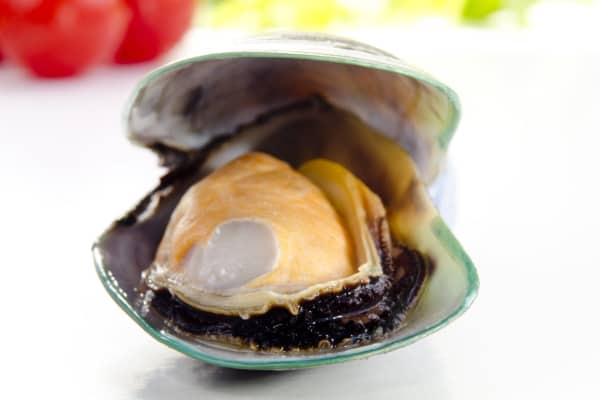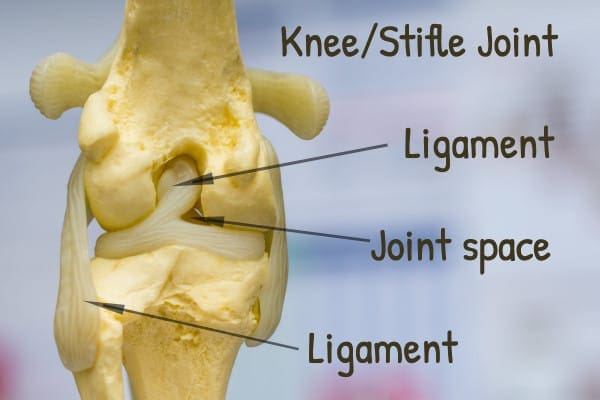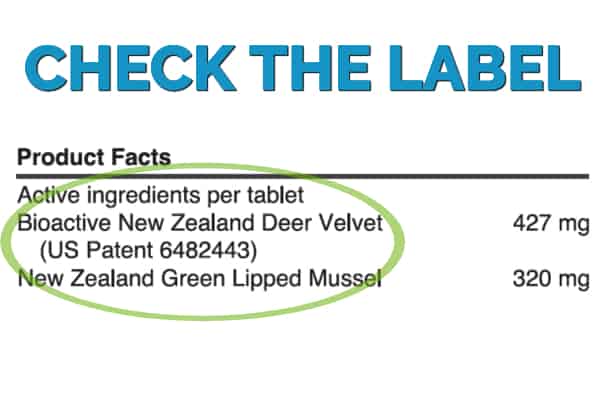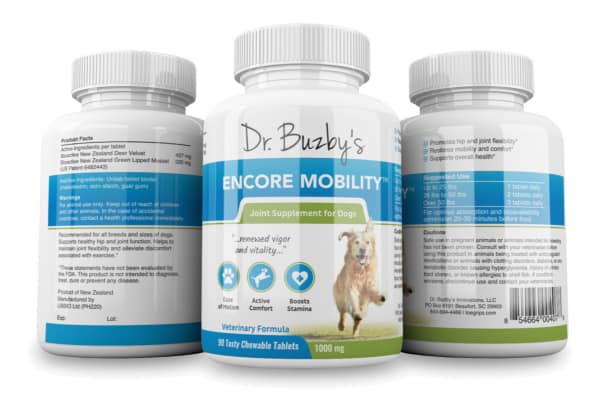What is green lipped mussel for dogs? If you share your home with a senior dog and you’ve never heard of green lipped mussel, this post is for you. Dr. Jane McNae — veterinary surgeon and founder of a physiotherapy and rehabilitation practice in Hong Kong— takes us inside the inflamed joints of senior dogs to show how green lipped mussel soothes and relieves joint pain and osteoarthritis.

I love dogs of all ages, but I have a super-soft spot in my heart for grey-muzzled companions as they start to feel, well, a little like me…stiff in the mornings! The truth is, joint and muscle pain can be debilitating for humans, and it’s the same for your aging dog.
To fully understand this, we need to journey inside the canine joint. Doing so will help you understand what triggers your dog’s joint pain and explain how green lipped mussel’s unique properties often help and even resolve this common senior dog health concern.
First, let’s define what green lipped mussel is and learn a little bit about where it comes from.
What is green lipped mussel for dogs?
Green lipped mussels, named after the bright green edge or lip around the shell, are unique to New Zealand’s pristine coastline. One of nature’s natural filters, green lipped mussels are rich in vitamins, minerals, and nutrients that provide anti-inflammatory relief to dogs suffering from joint pain and osteoarthritis.

For centuries, the indigenous Maori people of New Zealand knew the benefits of green lipped mussel. Their secret escaped only when scientists noticed that the coastal Maori people displayed a much lower incidence of joint issues and osteoarthritis compared to those living further inland. Scientists launched an investigation into what makes the green lipped mussel such a powerful anti-inflammatory. What they found has proven to be great news for senior dogs around the world!
To fully understand what makes green lipped mussel a powerful and effective supplement for your dog, it’s crucial to understand how joints work at their very best — and what happens when they don’t. So let’s briefly talk about joint pain and then embark on a tour of joint anatomy. Once we’re done, you’ll see why it matters which senior dog supplements you choose to soothe your dog’s pain.
Joints and joint pain in senior dogs
Joint pain is often caused by osteoarthritis. This common condition affects one in five dogs, mostly large breeds and overweight dogs. Osteoarthritis is a continuous degeneration and inflammation of the joints that causes mild to severe pain.

Let’s take a closer look at the anatomy of a joint to see how joints work and possibly pinpoint the source of your senior dog’s pain.
Four parts of a dog’s joint
1. The joint capsule
A capsule encases the entire joint. The joint capsule and the cells lining it are responsible for producing the joint fluid. A thick and inflamed joint capsule is unable to produce quality joint fluid and nutrients for the rest of the joint.
2. The joint fluid
The joint has a lovely fluid inside that works similarly to engine oil. Largely made of hyaluronic acid, the fluid not only lubricates the whole joint but also serves as the cartilage’s sole source of nutrition. Healthy joint fluid is viscous in consistency. If the fluid is thin or sticky, it has far less ability to move and spread nutrients to the joint.
3. The joint cartilage
Healthy cartilage inside a joint protects the bone and provides a smooth surface for movement, gliding, and cushioning during high-impact activities like running and jumping. The cartilage is a spongy matrix of glycosaminoglycans (GAGs) that retain water. The primary GAGs in cartilage are glucosamine and chondroitin.
4. The joint tendons and ligaments
Lastly, the tendons (which attach muscle to bone) and the ligaments (which connect bone to bone), cross the joint and aid in joint movement. If tendons and ligaments are sore, swollen, or irritated, dogs experience a tremendous amount of inflammation and pain.

Are you beginning to understand why your sweet dog doesn’t want to go for a walk? If so, you may be asking what you can do to relieve your dog’s pain.
It won’t come as a shock that we need to lessen the inflammation in order to reduce the pain. We do this with anti-inflammatory medications (NSAIDs), a host of physiotherapy techniques, and super-charged supplements with ingredients like deer velvet supplement for dogs and green lipped mussel. It’s that third option, supplements that contain green lipped mussel, we now turn our attention to.
How does green lipped mussel help dogs?
Naturally rich in omega-3 fatty acids, green lipped mussel is a dream for senior dogs with joint pain. These omega-3 fatty acids support immune health and are a natural anti-inflammatory. And best of all? Green lipped mussel contains the most critical omega-3s: eicosapentaenoic acid (EPA) and docosahexaenoic acid (DHA).
EPA and DHA omega-3s in green lipped mussel for dogs
The superheroes of green lipped mussel are EPA and DHA. They work by blocking the enzyme COX (cyclooxygenase). This villainous enzyme triggers the production of prostaglandins and other chemicals that cause inflammation in the body. With the enzyme blocked, there’s less pain, less swelling, less stiffness, and more mobility for your dog!
NSAIDs vs. green lipped mussel for dogs
As a side note, this is the same way NSAIDs reduce inflammation. However, NSAIDs sometimes cause troublesome side effects. Their inhibition of COX enzymes may also block helpful enzymes that protect some organs, in particular the liver and stomach lining. This does not appear to be as much of a concern with the COX inhibition provided by EPA and DHA.
Green lipped mussel also packs an extra punch compared to other EPA and DHA sources, such as fish oils. Remember the old infomercials that would promise, “But wait…there’s more!” That’s exactly what I would say about the fatty acids in green lipped mussel.
Scientists studying green lipped mussels identified an extra omega-3 fatty acid not seen in any other marine fish oils called eicosatetraenoic acid (ETA). It is a rare form of omega-3 that blocks a separate pro-inflammatory pathway called the LOX pathway.
Thus, green lipped mussel can block the formation of damaging prostaglandins and other inflammatory chemicals from two angles (inhibition of COX and LOX) while also protecting the liver and stomach. This may make green lipped mussel a safer choice when compared to NSAIDs in many senior dogs.
What are some other benefits of green lipped mussel for dogs?
Stay with me because green lipped mussels do much more than reduce inflammation! They also contain the building blocks of the joint cartilage and fluid that I mentioned earlier to help create a healthy joint.

Green lipped mussel provides chondroitin sulfate, glucosamine, and other GAGs which build, maintain, and repair joint cartilage and fluid. It also stimulates the joint capsule to increase hyaluronic acid production, thus improving lubrication for the joint.
Additionally, green lipped mussel contains vitamins C and E — antioxidants that further prevent or slow damage to cells. The minerals these powerhouse mussels absorb from the crystal-clear waters of New Zealand, such as copper, zinc, and selenium, are also a health boost to canine joint tissue.
Now that you know the benefits of green lipped mussel for senior dogs, let’s explore the best way to choose a supplement. But first, here is a quick summary of all the benefits (because there are just too many to remember)!
Green lipped mussel has the power to:
- Reduce inflammation
- Build, maintain, and repair joint cartilage and fluid
- Increase production of hyaluronic acid
- Prevent or slow damage to cells (thanks to vitamins C and E)
- Support joint tissue health with naturally occurring minerals
Does green lipped mussel for dogs really work?
Green lipped mussel does help senior dogs, and you don’t just have to take my word for it — the research backs it up! A study in the Journal of Nutrition showed a whopping 83% of dogs had lower pain scores and fewer signs of canine arthritis after just six weeks on green lipped mussel. In a separate Canadian study, vets and owners saw improvements in mobility and higher levels of omega-3s in the blood.
One caveat: When I start patients on green lipped mussel, it does take longer than NSAIDs to relieve arthritis pain in dogs. However, I usually see a good response in my patients after just a couple of weeks.
How can I choose the best green lipped mussel for dogs supplement?
Often, once dog owners learn about the incredible benefits of natural supplement for dogs like green lipped mussel, they are eager to talk with their vet and give it a try. And while I am just as eager to help, I want them (and you) to know there is much more to an effective supplement than popping the ingredients in a bottle and sticking a label on it.

Always lean on your veterinarian’s recommendation and experience, but here are a few key features to look for when selecting a product containing green lipped mussel.
- Make sure it’s sustainable: Choose a 100% natural supplement from New Zealand. Green lipped mussel is native to this incredibly gorgeous clean and green land. Plus, the government carefully monitors its production to ensure it’s safely sourced and sustainable.
- Make sure it’s clearly labeled: Choose a senior dog supplement from a reputable company and check the product label. Make sure green lipped mussel is listed as an active ingredient with the amount noted in milligrams. It should look something like this:

My favorite green lipped mussel supplement for dogs
Did you notice the other ingredient on the label above — the New Zealand deer velvet? It’s another one of my favorites.
Based in Hong Kong for the past 20 years, my culture is rich in Traditional Chinese Medicine (TCM) for both humans and pets. While I don’t profess to fully understand the ins and outs of TCM, I am able to study eastern medicine (TCM) ingredients, such as deer velvet, up close and personal.
In brief, deer velvet has growth factors that provide further anti-inflammatory effects and an immune system boost. Because of this, the merging of bioactive New Zealand deer velvet with green lipped mussel in Dr. Buzby’s Encore MobilityTM Joint Supplement for Senior Dogs, is a genius pairing of ingredients that support and maintain healthy joints and cartilage and boost immunity.
Save 10% on Encore Mobility™ Joint Supplement for Dogs

Give your dog more good days.
Use promo code HAPPY to save 10% on Encore Mobility.
Help your senior dog regain his mobility and dignity
If your senior dog is beginning to slow down, there are natural ingredients from our planet that can help regain his mobility and dignity. Proven to protect cartilage, repair tendons, and reduce inflammation, green lipped mussel gives senior dogs renewed vigor, reduced pain, and restored vitality.
Talk with your vet and ask about green lipped mussel for dogs. It may be the simple senior solution you’ve been looking for.
Do you have experience with green lipped mussel for your senior dog?
Share your experience in the comments below — we’d love to hear!


My dog has IVDD and we did NSAIDs in the begging along with gabapentin and robaxcin, but we noticed whenever we gave him the NSAID he had seizures and horrible side effects so I stopped giving it to him. However, his vet never gave us an alternative. Can I use this as a replacement?
HI Yoomi,
I am sorry your dog is having issues with IVDD and NSAIDs are not an option. While I am not sure this supplement has the ability to completely replace an NSAID medication, it is definitely safe to give along with the other drugs you mentioned. Please talk with your vet to make sure there are no reasons why staring a green lipped mussel supplement would be a problem for your pup. If you get the ok, I think you will be happy with the results and wish you the best of luck!
My pittie currently takes Cosequin but I feel like some days she’s having more pain so I thought I’d try the GLM. Because NSAIDS can damage other things I’m trying to avoid using them. She still gets around fine & walks daily 30-45 minutes. Sometimes only 20 if it’s really hot as she can no longer take the heat, is that a normal thing for seniors? Do you think GLM would be a good choice to help more with pain or is there another ingredient not in Cosequin that I should add instead? I’ve heard about CBG, UC-II, collagen, turmeric. Which is best specifically for pain? Thanks
Hi Leslie,
I am sorry your girl is having issues with arthritis pain. I do think GLM would be a good addition to her supplement regimen. Have you thought about trying Encore Mobility? Also, if you like Cosequin, I highly recommend you look into Dasuquin Advanced. It is made by the same company and includes turmeric, green tea, avocado/soybean unsaponifiables, MSM, EPA and DHA. It is basically the updated and improved version of Cosequin. I will attach links to other articles with more information and great ideas on how to decrease pain and inflammation. I am certain you will find some things to investigate that will help make your dog more comfortable. Wishing you all the best.
1. Natural Pain Relief for Dogs: 13 Methods
2. Deer Antler Velvet: The Science Behind the Supplement
3. How to Relieve Arthritis Pain in Dogs: The Ultimate Guide
4. Dog Arthritis Treatment: 8 Ways to Help a Senior Dog at Home
Hi, my aging lab is currently on an NSAID and I’m interested in either supplementing or replacing the NSAID with a GLM. If replace, is there a weening off period of time to consider? If supplement, is that safe and / or more effective?
Hi Rob,
There shouldn’t need to be a weaning off period for NSAIDs and it is recommended to use them along with supplements to achieve the best level of comfort. It is safe to give GLM with NSAIDs and I frequently use both in my patients with great success. Have you thought about giving Encore Mobility a try? If you decide to test it with your dog, please let me know what you think!
I came across GLM when looking for natural cancer supplements for my dog but could only find one article recommending it, everything else I have found only mentions joint pain relief. With it being high in omegas, would you recommend it dogs who have had cancer and for others as a general health aid? One of my dogs had cancerous liver tumours which were removed along with his spleen so his immune system must be less affective now. The other 2 are healthy but getting old so would it be good to start them all on GLM?
Hi Victoria,
I think GLM could definitely be of benefit for all three of your pups. Of course, I recommend you talk to your vet about adding this supplement to your dogs’ treatment plan. They can let you know if there are any concerns with GLM and other health issues your dogs may be dealing with.
I just recently learned our dog is getting arthritic. His vet prescribed NSAIDs for him since he’s 7, actually 8 now, yrs old. Would we be able to give him this supplement as well as the medication or would it be one or the other. I’d appreciate your commentary. Thanks.
Hi Patricia,
Yes, this supplement works great when paired with NSAIDs for arthritis pain!
If I have a breed (GSD mix) that traditionally gets joint issues, but she is young and healthy now, do I need to supplement?
Hello Paige,
Good question, and I understand your GSD-specific concern. I do believe starting a joint supplement prior to signs and symptoms of joint pain is wise. Think of it as the iceberg with the majority of the issue “under the water.” By the time we see clinical signs from joint disease, we are just seeing the tip of the iceberg. So yes, I do think starting a joint supplement in middle age is wise, before the senior years. However, my personal opinion is that you don’t need a joint supplement in a young and healthy dog. I think feeding a high quality/balanced diet, providing plenty of opportunity for safe exercise, and keeping your dog lean (here’s how you can tell: https://toegrips.com/canine-body-condition-score/) are the big goals for those early years.